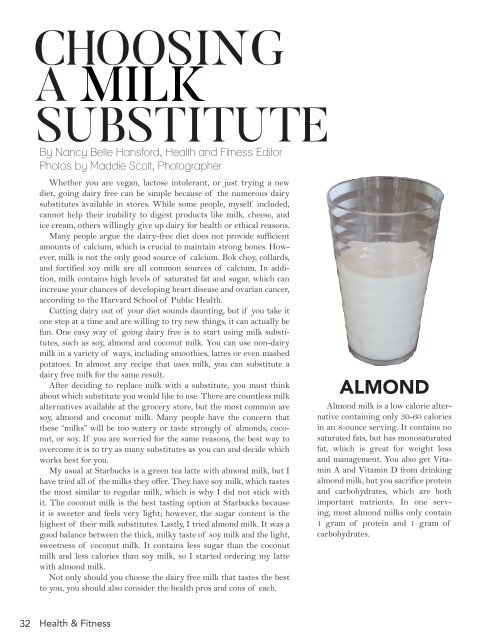Valkyrie Fall 2018 - Issue 1
Create successful ePaper yourself
Turn your PDF publications into a flip-book with our unique Google optimized e-Paper software.
CHOOSING<br />
A MILK<br />
SUBSTITUTE<br />
By Nancy Belle Hansford, Health and Fitness Editor<br />
Photos by Maddie Scott, Photographer<br />
Whether you are vegan, lactose intolerant, or just trying a new<br />
diet, going dairy free can be simple because of the numerous dairy<br />
substitutes available in stores. While some people, myself included,<br />
cannot help their inability to digest products like milk, cheese, and<br />
ice cream, others willingly give up dairy for health or ethical reasons.<br />
Many people argue the dairy-free diet does not provide sufficient<br />
amounts of calcium, which is crucial to maintain strong bones. However,<br />
milk is not the only good source of calcium. Bok choy, collards,<br />
and fortified soy milk are all common sources of calcium. In addition,<br />
milk contains high levels of saturated fat and sugar, which can<br />
increase your chances of developing heart disease and ovarian cancer,<br />
according to the Harvard School of Public Health.<br />
Cutting dairy out of your diet sounds daunting, but if you take it<br />
one step at a time and are willing to try new things, it can actually be<br />
fun. One easy way of going dairy free is to start using milk substitutes,<br />
such as soy, almond and coconut milk. You can use non-dairy<br />
milk in a variety of ways, including smoothies, lattes or even mashed<br />
potatoes. In almost any recipe that uses milk, you can substitute a<br />
dairy free milk for the same result.<br />
After deciding to replace milk with a substitute, you must think<br />
about which substitute you would like to use. There are countless milk<br />
alternatives available at the grocery store, but the most common are<br />
soy, almond and coconut milk. Many people have the concern that<br />
these “milks” will be too watery or taste strongly of almonds, coconut,<br />
or soy. If you are worried for the same reasons, the best way to<br />
overcome it is to try as many substitutes as you can and decide which<br />
works best for you.<br />
My usual at Starbucks is a green tea latte with almond milk, but I<br />
have tried all of the milks they offer. They have soy milk, which tastes<br />
the most similar to regular milk, which is why I did not stick with<br />
it. The coconut milk is the best tasting option at Starbucks because<br />
it is sweeter and feels very light; however, the sugar content is the<br />
highest of their milk substitutes. Lastly, I tried almond milk. It was a<br />
good balance between the thick, milky taste of soy milk and the light,<br />
sweetness of coconut milk. It contains less sugar than the coconut<br />
milk and less calories than soy milk, so I started ordering my latte<br />
with almond milk.<br />
Not only should you choose the dairy free milk that tastes the best<br />
to you, you should also consider the health pros and cons of each.<br />
ALMOND COCONUT SOY<br />
Almond milk is a low calorie alternative<br />
containing only 30-60 calories<br />
in an 8-ounce serving. It contains no<br />
saturated fats, but has monosaturated<br />
fat, which is great for weight loss<br />
and management. You also get Vitamin<br />
A and Vitamin D from drinking<br />
almond milk, but you sacrifice protein<br />
and carbohydrates, which are both<br />
important nutrients. In one serving,<br />
most almond milks only contain<br />
1 gram of protein and 1 gram of<br />
carbohydrates.<br />
Coconut milk is another low calorie<br />
milk substitute with roughly 50<br />
calories per 8-ounces in the unsweetened<br />
kind. This non-dairy milk contains<br />
five grams of fat, almost all<br />
of it being saturated, which can be<br />
linked to heart problems. In contrast,<br />
coconut milk does not have<br />
any protein and only two grams of<br />
carbohydrates.<br />
Soy milk is a protein packed milk<br />
alternative, with 7-12 grams of protein<br />
per 8-ounce serving. It contains<br />
hardly any saturated fat, which will<br />
help decrease risk for heart disease. It<br />
also contains less calories than cow’s<br />
milk, but more than other milk substitutes<br />
with roughly 80-100 calories<br />
per 8-ounce serving. When drinking<br />
soy milk, you must be careful not to<br />
drink it in excess because too much<br />
soy can disrupt hormones, especially<br />
in women.<br />
32 Health & Fitness<br />
33














